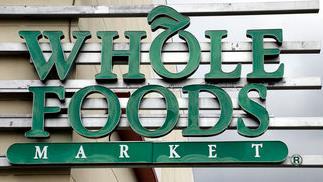Attention, Amazon Prime members who shop at Whole Foods: You're in luck
It's been a year since Amazon.com Inc. agreed to buy Whole Foods for $13.5 billion. The biggest beneficiaries of the deal might be Amazon Prime members.
Sky-blue signs advertising discounts for Prime members greet shoppers in some Whole Foods parking lots. Inside the stores, blue placards spotlight lower prices for Prime members on organic nectarines and sausage.
"Blue signs mean special deals just for you. Yes, you," declared leaflets that were arranged on a display table at a large Whole Foods in Oakland, Calif.
Amazon last week expanded free two-hour delivery of Whole Foods groceries for Prime subscribers to 14 cities, including Baltimore, Boston, Philadelphia and Richmond, Va. More than half of Whole Foods stores now offer a 10% discount on sale items to Prime members.
Whole Foods' new delivery service has led some customers to gripe. Some parking spots now are reserved for delivery drivers, and store sections have been converted to busy order-assembly areas. Some store entryways and service counters now are crowded with workers picking up orders, customers said.
"It can almost feel like mayhem," said Julie Gelfat, a 57-year-old communications consultant who stopped going to her local Whole Foods in San Diego after it added delivery. "There's no protocol to make the in-store customer feel relaxed."
Amazon and Whole Foods spokeswomen declined to comment.
Amazon is also making a hard sales pitch to get Whole Foods shoppers to sign up for Prime memberships.
"It was funny to be standing in a grocery store and hear, 'Would you like to be a Prime member?' " said Talia Smith, 25 years old, who lives in San Francisco. Ms. Smith said she is considering paying the $119 annual fee for Prime perks, now that they include lower Whole Foods prices.
Some analysts expect Amazon to use Whole Foods discounts as a way to capture even more retail spending by the grocery chain's largely urban clientele. Some 60% of Whole Foods shoppers are Prime members, Morgan Stanley analysts estimate.
Ethan Weiss, a 49-year-old physician and scientist in San Francisco, says he has switched most of his online grocery purchases to Amazon's quick delivery offering at Whole Foods from Instacart Inc. "It definitely felt like I got more for my money," he said.
Meanwhile, more Amazon products are turning up in Whole Foods stores. At some locations, Echo speakers, Fire tablets and Fire TVs are for sale alongside Amazon lockers where customers can pick up their e-commerce orders.
Customers browsing Amazon's website now are likely to see Whole Foods beans, baking soda and other store-brand goods displayed prominently. Amazon also appears to be giving a boost to Whole Foods' "365 Everyday Value" products. The chain's private-label sales have grown as a percentage of store purchases since the deal, according to advertising firm inMarket.
Sara Iyer, a 32-years-old podcast host from Los Angeles, said the store-brand products have drawn her to Whole Foods more regularly since Amazon took over. Her Amazon Prime credit card gives her an additional 5% cash back on her Whole Foods purchases.
The discounts appear to be driving stores traffic but the impact on the Whole Foods bottom line has been mixed. Year-over-year sales at Whole Foods stores are up an average of 3% since the takeover closed in August, according to an analysis of anonymized credit and debit card transactions by data firm Second Measure. But sales per customer are down by an average of 1%.
Still, many shoppers still don't know Amazon owns Whole Foods, according to a national survey by Field Agent, a data firm. Of 436 Whole Foods shoppers surveyed recently, 45% thought Amazon had made the chain better. More than 75% of Prime members who shop at Whole Foods said they intend to shop there more often, the survey found.
Write to Heather Haddon at heather.haddon@wsj.com and Laura Stevens at laura.stevens@wsj.com

